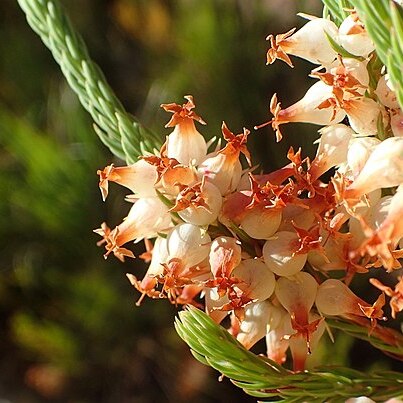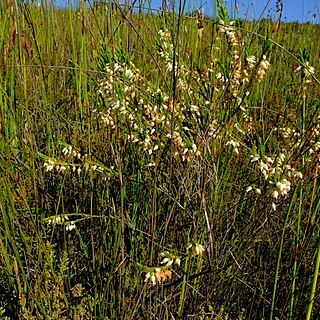Erect, glabrous, 1-1 1/2 ft. high; branches virgate, somewhat slender, the younger subangular, but not deeply channelled by the leaf-cushions, closely leafy above, naked below; leaves 3-nate, nearly erect, imbricate, internodes elongating, linear-trigonous, acute, sulcate, finely ciliolate, 5-7 lin. long; inflorescence axillary, in sub-3-nate tufts, forming a lax, mostly subsecund, false raceme, 2-4 in. long; flowers subcalycine, from erect to nodding; pedicels about 2 lin. long; bracts remote, lanceolate, scarious, small; sepals obovate or ovate, acute, distinctly imbricate, concave, keeled, scarious, pallid, about 2 lin. long, reaching from 1/2-3/4 the length of the corolla-tube; corolla ovoid-urceolate, much narrowed to the mouth, white or pink-tinged, about 3 lin. long; segments spreading (at least slightly), connivent in age, oblong and obtuse, or lanceolate and acute, about 1/5 of the tube in length; filaments capillary; anthers longitudinally broad-semiovate, obtuse, smooth, brown, 3/8 lin. long, minutely aristate; pore about 1/3 the length of the cell; awns subulate, spreading, not reaching below the base of the cell; style slender, clavate at the apex; stigma minute, capitellate or subconical; ovules flat, winged.
More
Erect shrub, up to 1.2 m high. Leaves 3-nate, imbricate, 10.5-14.7 mm long, linear-trigonous, acute, sulcate, finely ciliolate. Flowers axillary, in sub-3-nate tufts forming a lax, subsecund, false raceme. Flowers subcalycine, erect to nodding. Calyx sepals imbricate, ± 4.2 mm long, obovate or ovate, acute, concave, keeled, scarious, pallid. Corolla ± 6.3 mm long, ovoid to urceolate, white, pink-tinged or yellowish green; lobes spreading, oblong and obtuse, or lanceolate and acute. Filaments capillary; anthers broadly semiovate, obtuse, smooth, brown, 0.8 mm long, minutely aristate; pore ± 1/3 length of theca; appendages subulate, spreading, not reaching below base of theca, minute. Ovary with flat, winged ovules; style slender, clavate at apex; stigma minute, capitellate or subconical. Flowering time Apr.-Jan.
Erect shrub to 1.2 m. Flowers small, ovoid with spreading lobes, white or yellowish green.


